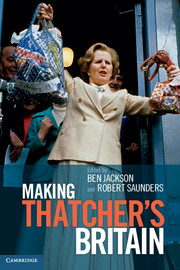Book contents
- Frontmatter
- Contents
- List of Contributors
- Acknowledgements
- Abbreviations
- Introduction Varieties of Thatcherism
- Part I Making Thatcherism
- Part II Thatcher’s Britain
- 6 Thatcher and the women’s vote
- 7 Margaret Thatcher and the decline of class politics
- 8 Defiant dominoes: working miners and the 1984–5 strike
- 9 Thatcherism, unionism and nationalism: a comparative study of Scotland and Wales
- 10 ‘Just another country’? The Irish question in the Thatcher years
- Part III Thatcherism and the wider world
- Appendices
- Notes
- Further reading
- Index
6 - Thatcher and the women’s vote
Published online by Cambridge University Press: 05 August 2012
- Frontmatter
- Contents
- List of Contributors
- Acknowledgements
- Abbreviations
- Introduction Varieties of Thatcherism
- Part I Making Thatcherism
- Part II Thatcher’s Britain
- 6 Thatcher and the women’s vote
- 7 Margaret Thatcher and the decline of class politics
- 8 Defiant dominoes: working miners and the 1984–5 strike
- 9 Thatcherism, unionism and nationalism: a comparative study of Scotland and Wales
- 10 ‘Just another country’? The Irish question in the Thatcher years
- Part III Thatcherism and the wider world
- Appendices
- Notes
- Further reading
- Index
Summary
Throughout Margaret Thatcher’s term as Prime Minister, women continued to prefer the Conservative Party to Labour in greater numbers than their male counterparts. This fact in itself was not surprising. While the differentials between male and female voting had varied as long as polling data had been available, the so-called ‘gender gap’ had always favoured the Conservatives. Only in 2005 did women begin to show a stronger preference than men for the Labour Party. However, the persistence of an aggregate gender gap masked significant class and generational trends within women’s support for the Conservative Party in the 1980s. Young women grew more pro-Labour over the course of the decade. After an initial flirtation with Thatcherism, women trade unionists also shifted to the Labour Party at the end of the decade. In contrast, middle-aged women barely waned in their support for the Conservatives, while older women remained a bulwark of Tory support. Ultimately, the swing to the left among younger women was stronger than the countervailing movement among older women, causing the gender gap to shrink considerably over the course of Thatcher’s premiership.
Scholars have devoted significant attention to the fall-off in Conservative support among women, arguing variously that the turn away from Thatcherism reflected the disillusionment of working women with Thatcher’s policies on women in the workforce; the betrayal felt by ‘Thatcher’s children’, both male and female, at the failure of the market economy to deliver for their generation; women’s support for the peace movement; and, finally, a long-term secular trend towards greater progressivism among women born after the Second World War. The continued appeal of Conservatism to a large section of British women, particularly middle-aged and older women, has, in contrast, received only slight attention.
- Type
- Chapter
- Information
- Making Thatcher's Britain , pp. 113 - 131Publisher: Cambridge University PressPrint publication year: 2012
- 6
- Cited by

